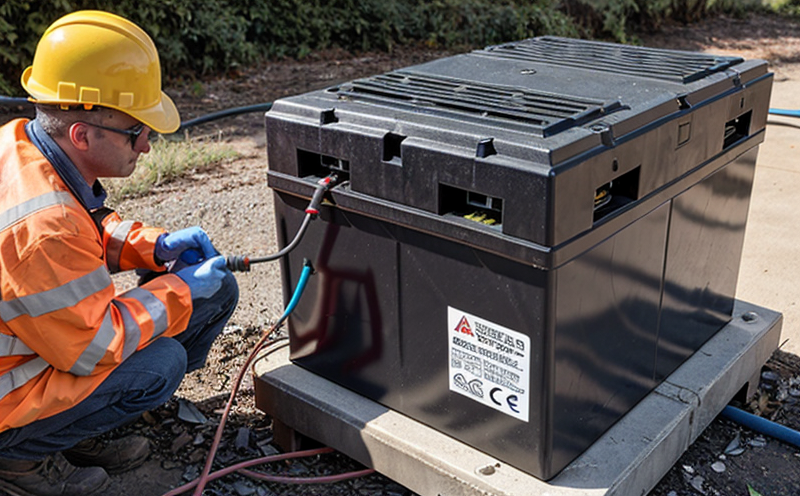IEC 60095-4 Lead-Acid Starter Battery Dimension and Safety Testing
The IEC 60095-4 standard is a crucial benchmark in the battery testing sector, particularly for lead-acid starter batteries. This service focuses on ensuring that these batteries meet stringent dimensional accuracy and safety requirements as outlined by this international standard.
Lead-acid starter batteries are widely used in automotive and industrial applications due to their reliability, cost-effectiveness, and ability to handle high current demands. The IEC 60095-4 standard ensures that these batteries are safe for use in critical environments while maintaining consistent performance across different manufacturers.
The testing process involves several key steps: initial inspection of the battery, dimensional measurement, electrical resistance testing, internal short-circuiting test, and visual inspection. Each step is designed to ensure that the battery meets the specified criteria laid out by the standard.
- Initial Inspection: This includes verifying the battery's type, voltage rating, and capacity label.
- Dimensional Measurement: Ensures the battery fits within the designated space and adheres to the manufacturer’s specifications.
- Electrical Resistance Testing: Measures how effectively the battery can handle electrical current without excessive resistance.
- Internal Short-Circuiting Test: Checks for internal defects that could lead to short circuits, which are dangerous in automotive applications.
- Visual Inspection: Ensures there is no visible damage or defect on the exterior of the battery.
The testing process not only ensures compliance with IEC 60095-4 but also helps manufacturers improve their products by identifying areas for enhancement. This service is particularly beneficial for quality managers, compliance officers, R&D engineers, and procurement teams who need to ensure that all components meet the highest safety and performance standards.
In real-world applications, these batteries are tested in various conditions to simulate the environmental stresses they might face during their lifecycle. For instance, temperature cycling tests can reveal how well a battery performs under extreme heat or cold, which is critical for automotive manufacturers operating in diverse climates.
The IEC 60095-4 standard ensures that these batteries are not only safe but also reliable and efficient. By adhering to this standard, manufacturers can ensure their products meet the highest quality benchmarks, thus enhancing customer satisfaction and trust in the brand.
Scope and Methodology
The scope of IEC 60095-4 testing includes ensuring dimensional accuracy, safety features, and performance characteristics that are critical for lead-acid starter batteries. The methodology involves a series of tests designed to validate these aspects.
| Test Type | Description | Objective |
|---|---|---|
| Dimensional Inspection | Measures the battery's external dimensions for accurate fitment in vehicles. | Ensures the battery fits within the designated space and adheres to manufacturer specifications. |
| Electrical Resistance Test | Tests the internal resistance of the battery under load conditions. | Evaluates how effectively the battery can handle electrical current without excessive resistance. |
| Internal Short-Circuiting Test | Simulates a short circuit internally to check for potential failure points. | Identifies internal defects that could lead to dangerous short circuits, especially in automotive applications. |
| Visual Inspection | Checks the battery's exterior for any visible damage or defects. | Evaluates the overall condition and safety of the battery before use. |
The methodology also includes temperature cycling tests to simulate real-world operating conditions. These tests are conducted over a range of temperatures to ensure that the battery can withstand extreme environmental conditions, which is crucial for automotive and industrial applications.
Quality and Reliability Assurance
- Consistency in Testing: Our laboratory uses standardized testing procedures to ensure consistent results across all samples.
- Calibration of Equipment: All instruments are regularly calibrated to maintain accuracy.
- Data Analysis: Comprehensive data analysis is conducted to identify any discrepancies or trends that require further investigation.
- Reporting: Detailed reports are provided, highlighting compliance with IEC 60095-4 and suggesting areas for improvement.
We pride ourselves on providing reliable and accurate testing services. Our team of experts ensures that every battery tested meets the highest quality standards. The detailed reports we provide not only confirm compliance with the standard but also offer valuable insights into potential improvements, making it easier for manufacturers to enhance their products.
Environmental and Sustainability Contributions
The testing of lead-acid starter batteries under IEC 60095-4 ensures that these batteries are safe and reliable, which contributes significantly to environmental sustainability. By ensuring that the batteries meet stringent dimensional accuracy and safety standards, we help reduce the risk of accidents and improve road safety.
Additionally, by promoting the use of high-quality batteries, our service helps extend the lifespan of vehicles, reducing the need for frequent replacements. This, in turn, leads to a reduction in waste generation and resource consumption, supporting environmental sustainability efforts.





